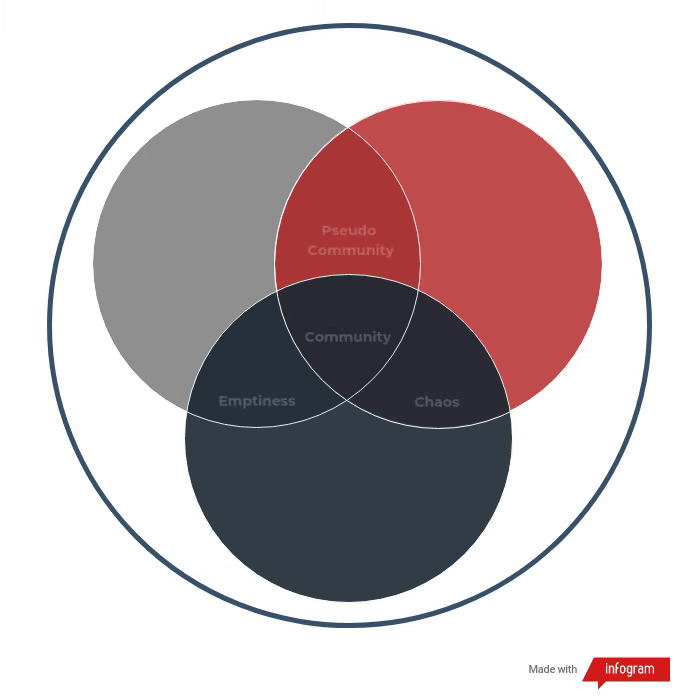Established in 1988, Chattanooga Endeavors is the first and longest-serving re-entry program in East Tennessee. #Chattanooga #SecondChances #IntegrativeJustice
Chattanooga Endeavors Tweet
Developmental Model
Community Building Workshops develop in four stages that Scott Peck refers to as pseudo-community, chaos, emptiness, and community. These stages are similar to those of other group dynamic theories — most notably Tuckman’s forming, storming, norming, and performing. What makes Community Building distinctive among those and of unique value to healthy and productive group behavior is: (a) its emphasis on process to the near exclusion of task; (b) the contingency stage of emptiness that group members experience as they advance toward Community; and (c) the fact that it is an experience of theory in practice. This being over doing approach helps participants to learn a way of being mindful in the presence of others and to consciously remove the barriers of misunderstanding that separate them from each other.
Teams that practice Community Building have a natural cohesiveness that is evident in the respect their members have for one another (cf. belonging, above), their ability to lean toward difficult issues with caring (cf. trust), and their commitment to discovery and change — both individually and collectively (cf. realism).
If we are going to use the word meaningfully we must restrict it to a group of individuals who have learned how to communicate honestly with each other, whose relationships go deeper than their masks of composure, and who have developed some significant commitment to “rejoice together, mourn together,” and to “delight in each other, make others’ conditions our own.”
M. Scott Peck, The Different Drum

Cycling through the Stages
Community Building is sometimes referred to as an emergent group process. This is because facilitators take special care to create the context that is needed for the group to emerge on its own. They rely on characteristically spare instructions and provide input only when they are sure it is needed — for example, to help a group that has become stuck in one of the stages. Aside from a simple story to begin the first session of the first day (usually, The Rabbi’s Gift), facilitators don’t even prepare content to discuss. Instead, content surfaces organically from what enters the Circle with each member — namely, their lived experiences in the moment.
There are four developmental stages in the Community Building model. The first two (Pseudo Community and Chaos) are every day encounters — the second two (Emptiness and Community) are rare and unexpected. The reason that we don’t often experience the second two is because most people don’t know how to manage the first two when they are together in groups. Chaos surfaces and is stuffed, surfaces and is stuffed — over, and over, and over again until Pseudo Community, which was once light and productive, becomes heavy and hard to get around in. What turns Pseudo Community against us is how we handle Chaos. Fight. Flight. Or, the third way — into and through Emptiness.
What we learn by building Community is both how to be more authentic in the first two stages when we are busy with our lives and how to intentionally enter into the second two stages when they are needed.
Pseudo Community
Pseudo Community is the front porch of Community in Peck’s model. It is dominated by convention, orderliness, superficial communication, and a search for similarities. In this stage, interactions are typically very polite — exchanging business cards and avoiding difficult issues. Trust is shallow. However it is shallow not because members are untrustworthy but because they are untested. The circumstances are uncertain and nothing much has happened to the group to reveal how members will behave under pressure. Rather than step into this uncertainty, members mostly keep to safe ground — and “talk about the weather.”
In the diagram above, members want to belong. However, the lack of trust makes belonging a shaky proposition.
Chaos
If Pseudo Community is the front porch of Community, Chaos is the back yard. It is characterized by efforts to manage the differences that begin to surface in the group, a lack of effective listening among members, the formation of cliques, efforts to solve each other’s problems, unrealistic expectations and judgments both of oneself and others.
In the diagram above, members grown weary of avoiding uncomfortable undercurrents and begin to speak out. This is a sort of realism. But is more or less confrontational — lacking the trust that is needed for members to speak very personally.
Emptiness
Emptiness is the bridge to Community. It is characterized by a letting go of the barriers which have been keeping members from being fully present and which have therefore been getting in the way of honest and meaningful communication. Such barriers may include expectations about Community Building or the Facilitators, resentments about something that was said or done in the group, the need to fix individuals or control the process, hanging on to old stereotypes, making snap judgments, wounds and rejections received in past relationships, etc.
Community
Community is characterized by the acknowledgment of and respect for individual differences; a depth of listening; an unusual level of group safety; the possibility of emotional and spiritual healing; shared leadership; softened (respectful) conflict; effective group decision making; a sense of belonging; a greater awareness of what stage the group is in and what is needed to move it forward.
Scott Peck describes these stages in detail in chapter five of his book, The Different Drum. You can download a copy of this chapter below.
Community Building Framework
A typical Community Building Workshop is conducted by two facilitators with 30-40 participants in a circle format over three consecutive days. The goal is for the group to experience the stage of Community by practicing a set of communication guidelines
You can learn a great deal about Community Building by reading what’s been written about the model. However, like other experiential models, the best way to understand it is to attend a Community Building Workshop.
Community Building Workshops at Chattanooga Endeavors are free. To learn about attending one, please contact us at (423) 266-1888 or
